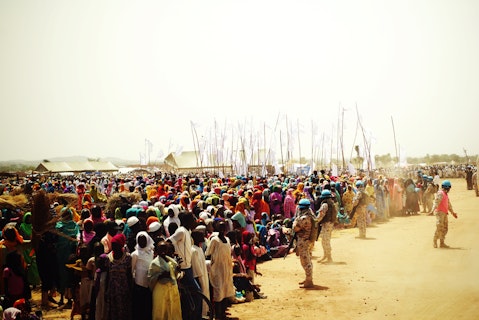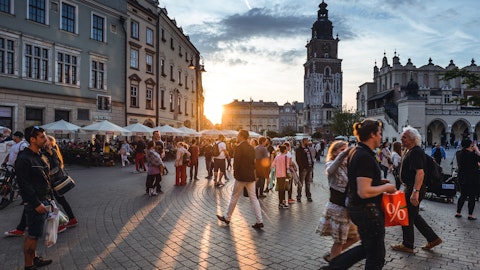In this article, we take a look at the 20 most refugee-producing countries in the world. If you would like to skip our detailed analysis of the refugee crisis, you can directly go to the 5 Most Refugee-Producing Countries in the World.
Refugee Situation Around the Globe
The UNHCR defines a refugee as someone forced to flee their country of origin as a result of persecution due to armed conflict, violence, or their identity, beliefs, and religion. The 2022 UNHCR Global Trends Report revealed that at the end of the year, there were 35.3 million refugees around the globe, 29.4 million of whom had a mandate of protection from the UNHCR. Another 5.9 million are cared for by the United Nations Relief and Works Agency, an organization set up particularly for Palestinian refugees. The total number of refugees at the end of 2021 had been 27.1 million, and hence, the growth till the end of 2022 was the largest yearly increase ever, according to the UNHCR database. In 2022, 339,300 refugees managed to return to their country of origin, and 114,300 were resettled.
52% of the world’s entire refugee population comes only from three countries: the Syrian Arab Republic, Ukraine, and Afghanistan. 70% of all refugees are hosted in countries neighboring the country of origin, which makes them some of the most refugee-hosting countries in the world. Low and middle-income countries host 76% of the world’s total displaced population. Türkiye is one of the world’s largest refugee hosts, home to almost 10% of the displaced population. Germany hosts 6%, whereas Europe as a whole hosts 36% of all the refugees currently displaced around the globe. Within the refugee population, 41% are children, 48% of whom remain out of school. Refugee children are 30% less likely than non-refugee children to complete primary school and 50% less likely to complete lower-secondary school. Only 68% of refugee children enroll in primary school, 37% in secondary school, and 6% in higher education or university.
Employment Conditions
The process of becoming a refugee carries a tremendous economic burden. Displaced individuals can often spend up to thousands of dollars in order to reach their country of refuge, which leaves them stranded without money for other essential needs. The UNHCR reports that two-thirds of refugees live in poverty. Thus, in this scenario, the provision of adequate employment opportunities becomes indispensable for refugee communities.
In 2016, the European Commission reported that refugees had an average employment rate of 56%, and it could take them up to two decades to achieve an employment rate similar to native-born individuals. The Commission also reports that almost 60% of all tertiary-educated employed refugees in the EU are overqualified for their positions, perhaps due to a lack of better opportunities.
The UNHCR further reports that 62% of refugees live in countries with restricted employment access, and 56% live in countries that do not recognize UNHCR or government-issued ID as a valid legal document for opening a bank account. Within Türkiye alone, 1 million Syrians are employed in the informal sector, and 75% earn less than the minimum wage. Furthermore, 59% of refugees live in countries with restricted access to registering and opening a business. This severe lack of opportunities is further worsened by issues such as language barriers and disproportionate discrimination against refugee populations. You can also take a look at the 15 Countries with the Most Climate Refugees in the World.
The Solution
The UNHCR runs several programs, such as cash-based interventions and microfinancing programs, that enable refugees to find employment and fend for themselves, but businesses also play a crucial role in this regard. Amazon.com, Inc. (NASDAQ:AMZN) announced on June 19, 2023, that it planned to employ 5,000 refugees in Europe within the next three years. This news came less than a year after Amazon.com, Inc. (NASDAQ:AMZN) had announced hiring 5,000 refugees within the US by the end of 2024. This was an excellent opportunity for countries with the most refugees in the US, as the program also provides access to other opportunities such as skills training and legal advice. Amazon.com, Inc. (NASDAQ:AMZN) is also working to provide training to almost 10,000 Ukrainians within its ITSkills4U program, a free opportunity for Ukrainians to advance their careers in IT.
Microsoft Corporation (NASDAQ:MSFT) is another company providing opportunities to refugees. On June 19, 2023, the Tent Partnership for Refugees announced that Microsoft Corporation (NASDAQ:MSFT) had been one of the 40 companies to pledge refugee support at the Tent European Business Summit. Microsoft Corporation (NASDAQ:MSFT) pledged that over the next three years, it would train around 5,000 refugees in essential IT skills, such as coding and cybersecurity, while also helping them gain a better understanding of the European job market. The company also provides entrepreneurial training to refugees so that they may be equipped with the tools required to set up one’s own business.
While the general focus continues to be on the idea that refugee populations can cause economic burdens for host countries, a 2019 report by the American Immigration Council revealed their contributions as well. According to the report, in 2019, refugees in the US had contributed $25 billion in taxes and generated $5.1 billion in business income. Refugee populations across 17 states were showcased to have a combined spending power of $1 billion. Hosting refugees poses a critical situation, but the examples of companies such as Microsoft Corporation (NASDAQ:MSFT) prove that refugee populations can be empowered to deliver economic benefits to themselves and the host country. With this context, here are the 20 most refugee-producing countries in the world whose displaced populations require continuous actions by businesses and host governments alike.

20 Most Refugee-Producing Countries in the World
Our Methodology
In order to compile this list of the 20 most refugee-producing countries, we consulted the World Bank dataset on refugees by country of origin. The countries are listed in ascending order from least refugees to most, based on the total number of refugees the country had in 2022. Any refugee outflows during 2023 have not been accounted for in this dataset. Further insights have been added from recent UNHCR reports on refugees. Based on this methodology, here are the 20 most refugee-producing countries in the world:
20 Most Refugee-Producing Countries in the World
20. Cameroon
Number of Refugees: 147,359
In 2022, the UNHCR reported that while 30,800 Cameroonian refugees had managed to return to the country from Chad, 147,359 were still displaced. Most refugees are from the northwest and southwest regions of the country, where there’s an active conflict between the government and activist groups. Most Cameroonian refugees are hosted in Nigeria.
19. Sri Lanka
Number of Refugees: 148,082
Most Sri Lankan refugees reside in India after having fled from their country due to economic turmoils. With almost 150,000 refugees by 2022, Sri Lanka is one of the world’s most refugee-producing countries.
18. Ethiopia
Number of Refugees: 149,245
Millions of Ethiopian refugees have been forced to flee the country in the past few decades due to ongoing ethnic violence. The country itself is home to thousands of refugees from the surrounding countries of Eritrea, South Sudan, and Somalia, which puts the region in the middle of a complex refugee situation.
17. China
Number of Refugees: 161,234
Most of the displacement in China happened due to natural disasters such as cyclones, floods, and tropical storms. Economic sustainability is another reason thousands of people are fleeing the country to seek a better lifestyle. This is why China is one of the most refugee-producing countries in the world.
16. Mali
Number of Refugees: 226,720
The UNHCR reports that in 2022, 28,500 Malian refugees, mainly in Mauritania and Burkina Faso, were recognized as refugees on a group basis. Violence and threats by armed groups are one of the main reasons why the Malian population has a considerable number of refugees.
15. Venezuela
Number of Refugees: 234,376
Of all the new asylum applications received in 2022, more than 2 in 5 were made by individuals from Latin America and the Caribbean, which included a high proportion of Venezuelans. Political turmoil and socio-economic instability are two of the main reasons why people are fleeing Venezuela.
14. Rwanda
Number of Refugees: 249,685
The ethnic hostility that has been going on in Rwanda for decades is why it is still one of the most refugee-producing countries in the world, with a refugee population of 249,685 in 2022. Most Rwandan refugees remain scattered in neighboring countries, and only a small percentage has been able to return home.
13. Iraq
Number of Refugees: 288,261
At least 36,000 Iraqi nationals filed asylum applications in 2022, which was the second-highest number in the Middle East and North Africa region after the Syrian Arab Republic. During the year, 2,600 Iraqis also received resettlement in Canada, which was one of the biggest resettler countries of the year.
12. Burundi
Number of Refugees: 320,536
In 2022, 10,100 Burundian refugees had managed to return home from Uganda, but another 320,000 are still in refugee status. The contested elections and violence of 2015 are some of the main reasons why people have fled Burundi, making it one of the most refugee-producing countries in the world.
11. Nigeria
Number of Refugees: 391,074
In 2022, 26,400 Nigerians applied for new asylum applications, with the country having produced a total of 391,074 refugees. Furthermore, 27,200 Nigerians, mainly hosted in Cameroon and Niger, received refugee recognition on a group basis. 10,700 Nigerian refugees also managed to return to the country from Niger.
10. Eritrea
Number of Refugees: 508,291
In 2022, Eritrean refugees showcased a 27% increase in asylum applications, with applications being filed by 38,000 individuals. 6,100 Eritreans also received resettlement in Canada, whereas 4,700 received permanent residence or citizenship in their host countries. Ethiopia, Egypt, and Sudan are among some of the top countries hosting Eritrean refugees.
9. Central African Republic
Number of Refugees: 748,327
Conflict and violence in various regions of the country are the reasons behind the huge refugee population from the Central African Republic. In 2022, 404,600 internally displaced people within the country managed to secure their return.
8. Somalia
Number of Refugees: 790,513
The ongoing conflict, floods, and droughts are forcing Somalians to flee their country, even in 2023 and 2024. Climate change is one of the biggest reasons countries in the Horn of Africa continue to become hotter and drier, pushing more and more individuals into a state of insecurity.
7. Sudan
Number of Refugees: 836,756
The conflict between armed groups in Sudan has placed the region in a state of dire insecurity. The country has millions of internally displaced individuals and thousands of its own refugees while also hosting refugees from other conflict-ridden countries in the region, such as South Sudan. This is why Sudan is one of the most refugee-producing countries in the world.
6. Democratic Republic of Congo
Number of Refugees: 931,903
As insurgencies and conflict escalated in the North and South Kivu and Ituri provinces, millions of Congolese individuals had to be displaced inside and outside the country. This is why the Democratic Republic of Congo ranks sixth on our list of the world’s most refugee-producing countries.
Click to continue reading and see the 5 Most Refugee-Producing Countries in the World.
Suggested Articles:
- 20 Countries with Highest GDP per Capita by 2024
- 15 Fastest Declining States in the US
- 20 Countries with the Lowest Homeless Population in the World
Disclaimer: None. 20 Most Refugee-Producing Countries in the World is originally published on Insider Monkey.





